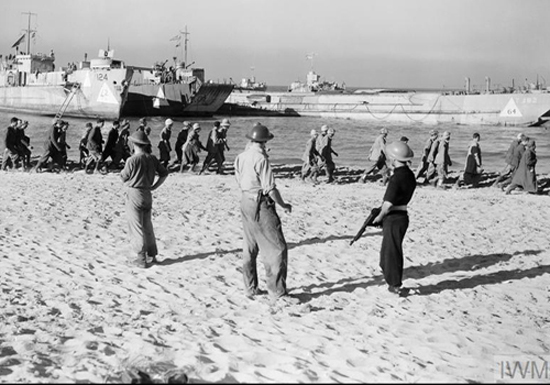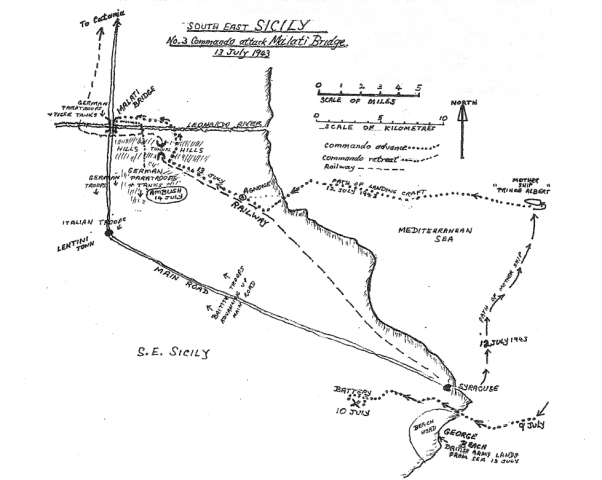‘Sicily - Operation Husky’

The invasion of Sicily. In addition to Commando units the Special Raiding Squadron (SRS) also participated. Whilst the SRS were engaged at Bagnara and Augusta and other areas, No 3 Commando's time in Sicily included one particular action at Agnone.
On the 14th/15th July 1943 No.3 Commando were tasked with taking and holding a bridge at Malati until the arrival of the 50th Division. After capturing the bridge from the Italians and removing the demolitions they had laid, a counter attack by the Germans with support of tanks inflicted heavy casualties on No.3 Commando.
Eventually they were ordered to withdraw, but the bridge had been saved from demolition.General Montgomery later ordered that a stone be carved with “3 Commando Bridge” and this stone cemented into the Malati bridge. An excellent account of the action can be found here :
Recollections of Sicily and Malati Bridge by Lieut. John Channon Erskine RE & No.3 Commando
One of the pillboxes still remains at the bridge and it can be viewed HERE.
The graves of some of the fallen from No 3 Cdo during this operation can be viewed on this link to our gallery for Syracuse War Cemetery
On the 22nd July 1943 No 2 Commando were sent to the action in Sicily. Read more about their part here in our No 2 Commando History section.
'Assault and Holding of Punta dei Malati'
Sam Hooper and Bill Everett
In 1942, an elite group of 120 former policemen joined one of the British Army's most notorious commando units.
In the early hours of 13th July 1943, Sam Hooper and his friend Bill Everett - both former policemen from Cardiff - stood on the deck of a British warship, surging towards the Bay of Agnone in Sicily.
"It was a very fast boat and it dropped us off about a mile from the beach," he recalled, "We had six landing craft on the boat and we went in formation to the beach in darkness. When we landed we had some terrible opposition from the Germans, but we got away with it."
It is a simple statement, but in fact the day was later recalled by one war historian as the 'most perilous enterprise' of the elite No.3 Commando unit's career.
It was Mr Hooper's third day of active service with the unit after a year of intensive training - and it was to be his last of the war.
He was one of a dozen policemen from Cardiff, who joined the unit in 1942, shortly after restrictions preventing police from volunteering with the armed forces were lifted.
Sam recalled how he and Mr Everett, who has since passed away, were put through rigorous training at the Commando Depot at Achnacarry in Scotland - where five-mile runs were a daily chore and being shot at with live ammunition was par-for-the-course.
"When I was home my mother would say things like, "Has that vest been aired?" he said.
"At Achnacarry it was wet socks and boots every morning and we would finish the day by walking through a river."
In January 1943, the former policeman and the rest of No.3 Commando boarded a boat for Gibraltar.
"I'll always remember that journey because it was absolutely horrific," he said.
"The biggest boat I had been in was a rowing boat in Roath Park, and here I was with waves 30ft high - it frightened the life out of me."
After spending some time in Gibraltar, the unit sailed to Suez in Egypt, where they began preparations for the allied invasion of Sicily. On 10th July 1943, Mr Hooper became one of the first Allied troops to set foot on Italian soil when he helped take down an enemy gun unit ahead of the invasion.
Just three days later his unit was sailing again under cover of darkness towards the Bay of Agnone, tasked to move up the beach behind enemy lines and take a bridge that had been rigged with German explosives. "The bridge was five miles inland and there were 350 of us," he said.
"We had a new type of weapon called a PIAT mortar, which went right through a tank and hit an ammunition wagon.
There was an enormous explosion and we all ran off, just as a Tiger tank came over the bridge and bombarded the devil out of us.
We had to split up and the group of chaps I was in ran straight into a German parachute division."
Mr Hooper and Mr Everett were both captured and taken by boat to Italy. Halfway through the journey, their ship was attacked by Allied aircraft.
"I was lying face-down and making myself the thinnest man in the British army to avoid being shot," he said.
Once on the mainland, the prisoners were handed over to the Italian army and taken to a 'flea-ridden' PoW camp near Naples, before being moved on to Austria.
There the camps were smaller and, although he and Mr Everett were separated, life was a little easier. But it did not stop Mr Hooper getting himself into trouble.
"When they asked us what we did I said I was a farmer," he said. "I was sent out to a farm and the woman in charge asked me if I could milk a cow. Of course I said yes - how hard could it be?"
"So she went and got a cow, put a stool and a bucket next to it and said, "Get started". I thought it was going to be easy, but I couldn't get a drop of milk. She realised pretty quickly that I wasn't a farmer."
Another time, he attempted a daring one-man escape on foot to Hungary, but was caught by German patrols on high alert after a mass break-out at a larger POW camp nearby.
"I was marched up before a military court and put in prison for several days," he said. "It was the first and only time I had a criminal record."
Finally, in May 1945, Mr Hooper was liberated and taken to France, from where he got a lift home to Britain in a Lancaster bomber.
"When I got home to Cardiff I didn't bother with the bus, just walked home to Whitchurch," he said. "When I saw my family it was an incredible feeling, unbelievable."
After a 'short break', he was back on the beat as a policeman in the city's Canton area, before joining the traffic department, where he and Mr Everett both remained until their retirement in 1971, after 30 years of service.
